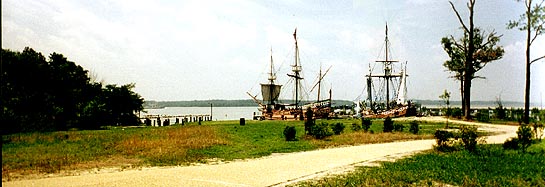Virginia History

Replicas of the Susan Constant and Godspeed on Chesapeake Bay at Powhatan
Village, Virginia, photo by Elroy Christenson, 1995

Replicas of the Susan Constant and Godspeed on Chesapeake Bay at Powhatan
Village, Virginia, photo by Elroy Christenson, 1995
The first group of 150 adventurers came to Cape Henry of
Chesapeake Bay on May 6, 1607 aboard three ships, the Susan
Constant, Godspeed, and Discovery. They were sent here by the
Virginia Company established in England as a stock company to look
for treasures in the new world and spread the word of
Christianity. They picked a site up river but in a swampy region
with poor fresh water supply. The whole settlement would have been
abandoned had not supplies and new settlers arrived in 1610. By
this time about 2/3 had died of malnutrition, Malaria, pneumonia
and dysentery and the remainder were only held together by the
leadership of Capt. John Smith. 1609-1610 is known as "The
Starving Time."
"There at Jamestown and on James River was the cradle of the
Union - The first church, the first blockhouse, the first
wharf, the first glass factory, the first windmill, the first iron
works, the first silk worms reared, the first wheat and tobacco
raised, the first peaches grown, the first brick house, the first
State house, and the first free school (that of Benjamin Syms,
1635)." [Tyler p. 4]
One of the first industries developed here was glassblowing due
to the abundance of firewood and silica. Iron smelting was also
attempted along with wine and beer making. By 1612 a new type of
sweeter tobacco was introduced as a cash crop. The sustaining
crops included corn and hogs although the settlers also tried
growing silk, grapes. During this first period, the
colonists were treated unevenly in their tenure for
expenses. When the colonists had their passage paid by the
"Virginia Company" they had to work for the company for eleven
months of the year, the twelfth month they could work for
themselves. This type of servitude fell out of favor when
compared with the hundreds of immigrants to Bermuda who paid
annually two and a half barrels of corn and not required to do
public service. Under the rule of Thomas Yeardley tobacco
profits took precedence over safety to colony. Tobacco was
grown in any small plot of land including down the center street
of Jamestown. In 1619 Captain Samuel Argall became the
deputy -governor of Virginia. His governance was sever,
despotic and while exercising power mostly for personal
gain. April 18th Sir George Yeardley brought the removal of
Argall and granted the colonists all the rights and privileges of
freemen as well as substituting English statute law instead the
previous military code. After this change there was no shortage of
food and the Indians now became the purchasers of corn.
[Authur & Carpenter 121-123]
By 1619 there were about six hundred to a thousand people living
in the Virginia colony. In this year began the first importation
of "young handsome and honestly educated maids" for potential
marriages. Under the governance of Sir Edwin Sandys of
only one year, the London Company "provided passage for twelve
hundred and sixty-one immigrants, among whom were ninety young and
incorrupt women." The success of this first contingent of women
helped to make way for the second group of sixty more in 1621.
[Authur & Carpenter 127]
In John Burke's History of Virginia, Vol. No. 1
appendix, is the name of Lawrence Camp who while in England in
1620 was a large subscriber to the fund for colonizing Virginia.
Lawrence was called a "Member of the Great Charter of the Virginia
Company" when it was granted by King James I on May 23, 1609. He
was a member of the Company of Honorable Drapers and Weavers. He
had owned seven shares of stock in the Company which he was
allowed to draw 700 acres of land in Gloucester County, Virginia.
This land fell to his brother Thomas Camp upon his death. This
Thomas may have had a son, Thomas Camp,
who is one of the early known settlers. There was also a
Richard Kemp that also built one of the first brick houses in
Jamestown but no known connection is documented.
William Ewens was a sea captain
responsible with bringing many settlers, indentured workers and a
few slaves to Jamestown on his several ships and voyages. He
ended up owning a thousand acres just across the river from
Jamestown. His daughter, Mary, marries Andrew Barron about
1670.
The original settlement of Jamestown continued prosper with difficulty for a few years. A brick church was constructed here in 1639 with a tower added in 1647. Although very restored from ruins, it is today "one of the oldest English-built edifices standing in the United States." Jamestown was burned to the ground in Bacon's Rebellion in 1676 and burned down again in 1698. Most of the population moved inland by 1699 making Williamsburg the new governmental and cultural center of Virginia.
Sources:
Elroy's Family Index | Return to Chart #192 | Local History Index / Surname Index






All information and
photos included within these pages was developed by
the help of hundreds of researchers. The information
here is for the express purpose of personal
genealogical research and is freely offered as long as
this site is listed as a source. It may not be
included or used for any commercial purpose or
included in any commercial site without the express
permission of Elroy Christenson. Copyright Elroy
Christenson 1998-2010.